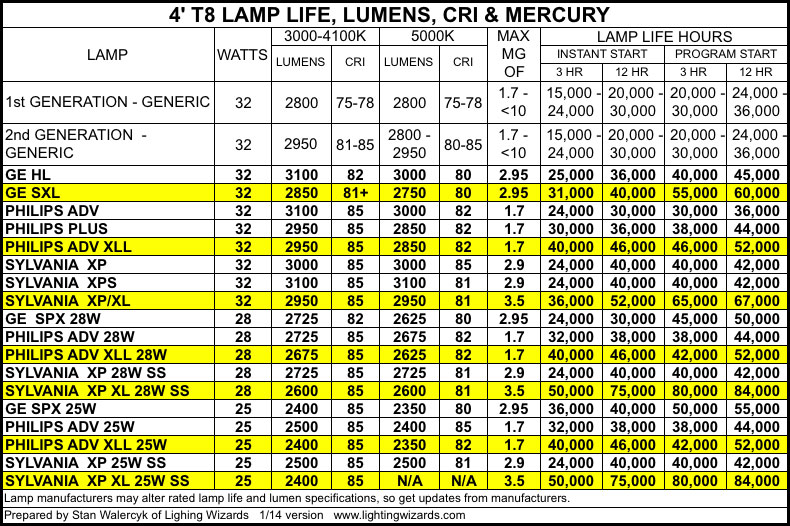Stan Walerczyk
Although maintenance costs are mainly an end user concern, distributors and contractors, who provide low maintenance costs options to customers, will probably increase sales compared to their counterparts, who do not. Especially since 2008 when the economy tanked, many end customers have greatly shrunk their maintenance staffs, so low maintenance products and systems are very important.
In general I think it is good for distributors, contractors and other lighting professionals to provide options to customers and go over the pros and cons of each option with their clients. Even on bid projects, contractors and contractors can often win projects with alternative bids as long as they also provide standard bids.
Although many people think that LED products always have the longest life, there are extra long life fluorescent T8s with up to 84,000 hour rated life. That is longer than many LED products, which are only rated for 50,000 hours. Plus these extra long life fluorescent T8s may only cost $3 – $4 to distributors and contractors. If you are not already aware, most electronic ballasts are rated for about 60,000 hours. The lamps with yellow background in this table are extra long life fluorescent T8s. There are also some extra long life fluorescent T5s and T5HOs.
It may be important to be aware that not all extra long life fluorescent T8s, especially with certain Kelvins, are approved by the Consortium for Energy Efficiency, so may not qualify for local rebates.
www.cee1.org
For LED products to provide lower maintenance costs than extra long life fluorescent, LED products need to have:
- At least 100,000 hour rated life
- Up to 10 year warranty
- Either cost effectively retrofitted with new LEDs and drivers or cost effectively fully replaced
Rated life on LED products is typically when the LEDs still have 70% of initial lumens, which is called L70. Drivers and other components will probably fail before LEDs. This was shown in DOE’s recent hammer test.
I think that warranty is much more important than rated life of LEDs, because warranty is how long the manufacturer will stand behind the entire product, including LEDs, drivers, electrical connections, door hinges, etc. So a 50,000 hour rated product with a 10 year warranty can be better than a 200,000 hour rated product with a 5 year warranty. Most LED products, other than just lamps, have a 5 year warranty, but some manufacturers, including Cree, Finelite and Leotek offer standard 10 year warranties. But many manufacturers will double their 5 year warranties if the purchaser is willing to spend an extra 5 – 10% up front. This can be very good for both manufacturer and customer. End users are much more comfortable approving proposals if the warranty is longer than when payback happens.
If you are not already aware warranties on most LED products are parts only, while most fluorescent ballasts also have at least a $10 labor credit.
Some interior and exterior LED products have easily replaceable LEDs and drivers, while others do not. For example, with LED troffers and troffer kits, it is recommended to get ones that LEDs and drivers can be replaced by just lowering the lens door and not having to lift any ceiling tiles.
In general, LED products cost more than linear fluorescent ones, and even if the LED products have 10 year warranties and save 30% more wattage than the best fluorescent, if they cost so much initially and/or cost so much to retrofit or replace, they may not be cost effective.
Disposal/recycling may be relevant. Many areas require fluorescent lamp recycling, which may cost about $.10/foot. But that is not a big issue with extra long life lamps. Plus a can of tuna fish usually has more mercury than many 4′ fluorescent T8, T5 and T5HO lamps. Most LED products have a lot of valuable aluminum heat sinking, which should be recycled. In the future, LED products may have to be recycled like existing TVs, computers and other electronic devices. So an added cost may be included when LED products are purchased, just like these other electronic devices.
Please let me know what you think of any of my statements. Also, if you have a lighting subject that you would like information about, let me know. stan@lightingwizards.com
Tagged with Exclusive Feature, LED, lighting, tED





